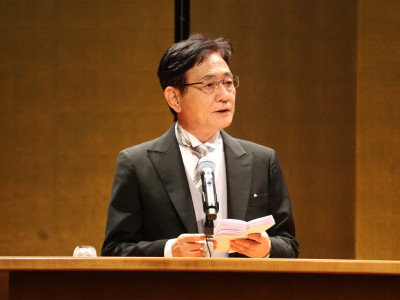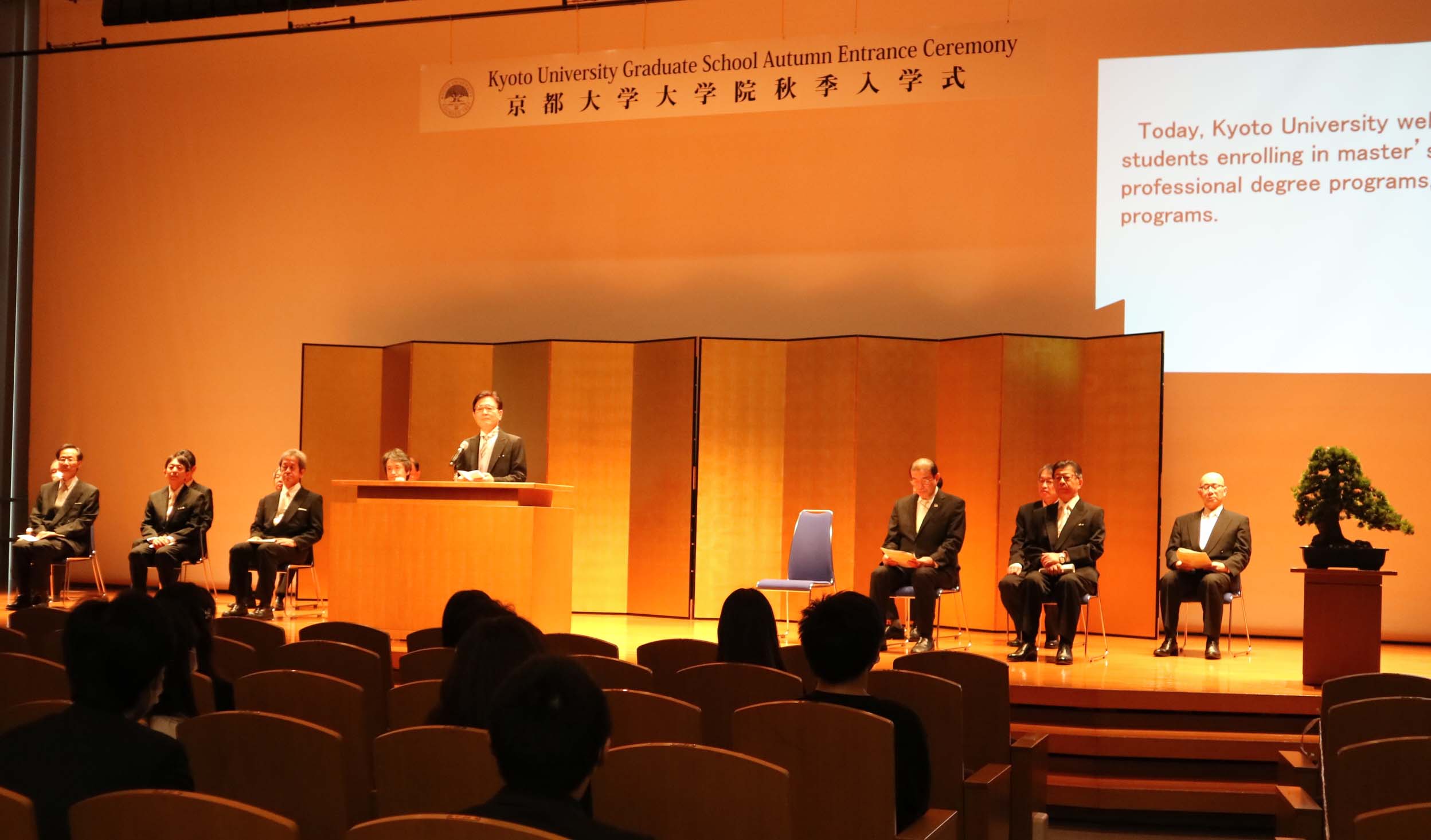Nagahiro Minato, 27th President

Today, Kyoto University welcomes 63 new students enrolling in master's programs, 6 in professional degree programs, and 105 in doctoral programs. On behalf of all faculty members and staff, I congratulate each and every one of you on your entrance into Kyoto University. I also extend my warmest congratulations to your families, and all those who have encouraged and supported you thus far.
You are now taking a new step toward mastery of your chosen fields of specialization here at Kyoto University, where graduate studies are supported by 10 faculties, 18 graduate schools, 13 affiliated research institutes, and 17 other education and research facilities, spanning a wide range of disciplines. Students in our master's programs are expected to acquire advanced knowledge and skills, and develop their abilities as researchers through classes, practicums, and fieldwork that build on the basic knowledge and expertise acquired at the undergraduate level. Doctoral programs focus on the production of a doctoral thesis. The key elements of that task include data-gathering, analysis, and a comparative review of new findings with existing research. Kyoto University also provides five Leading Graduate School Programs and two doctoral programs for the World-leading Innovative and Smart Education (WISE Program), in which students acquire the practical knowledge and technological skills needed to address issues in modern society.
This year, due to the novel coronavirus (COVID-19) pandemic, many of the University's newly enrolled international students are unfortunately not yet able to come to Japan. This has made it necessary for some of our new graduate students to participate in this entrance ceremony for the 2020 autumn term online. It is unfortunate that I cannot meet all of you in person to celebrate your enrollment, but I am very happy to send this message of congratulations to you today via online video.
Today, you are taking your first steps towards new lives as researchers in various fields, enrolled in the master's, professional, and doctoral programs of Kyoto University. Kyoto University was established in 1897 as Japan's second imperial university. Prior to the 20th century, universities in Europe served as institutions for the training of priests, lawyers, doctors, and other specialized vocations. In a similar way, the mission of Japan's imperial universities, which were established after the Meiji Restoration, was to foster professionals with expertise and practical skills in different fields, in order to promote the government's modernization policy.
However, the second industrial revolution, which began in the late 19th century, led to a rapid expansion of the role of science and technology in society. This situation gave momentum to the idea that research, which had formerly been undertaken at private academies, should be included in university activities. Germany was burgeoning at that time, and the University of Berlin developed a new style of higher education, one in which research and teaching were integrated, and students were taught through research. This came to be known as the Humboldtian model of higher education, and it embodies the university philosophy that respects "academic freedom", independent of the government, enabling researchers and students to seek the truth and acquire knowledge through self-directed research.
Amid these structural transformations by universities, Kyoto University, established as Japan's second imperial university, became the nation's first institution to adopt the German research-oriented model. Johns Hopkins University and the University of Chicago were established in the US around the same period. Since that time, Kyoto University has pursued "education through research", based on its motto of "academic freedom". It can be said, therefore, that Kyoto University was the first research-oriented university in Japan.
Research should be motivated by an individual's curiosity and desire to explore the unknown. However, as the impact of science and its applications in human life increase, science and technology have become inseparable, and their role continues to rapidly expand and diversify.
Recently, we often hear the terms "basic science" and "applied science", and finding an appropriate balance of public support between the two is currently a hot topic of debate. The distinction between basic and applied science originally appeared in a 1945 report entitled "Science — The Endless Frontier", which was authored by Dr Vannevar Bush, who at the time was guiding science policy as director of the US Office of Scientific Research and Development. In that report, which was submitted to President Harry S Truman, Dr Bush categorized science into basic science, which focuses entirely on research, and applied science, which focuses on the development of products. Dr Bush asserted that public funding should not be provided to companies engaging in applied science, but that it should be provided to universities, so that they could pursue basic research.
Dr Bush's opinion may be a surprising one, considering the recent discussions in Japan about industry-academia collaboration. However, it was actually reflected in the US science and technology policy during the Cold War, and seems to have served as the foundation that enabled the post-war US to lead global science and technology in terms of both quality and quantity. Of course, the simple dichotomy of basic science and applied science is no longer a realistic classification. It is now not unusual that basic research, motivated by pure inquiry, drives the development of ground-breaking applied research in a very short time-frame. I myself have experienced this at the frontier of immunological research. I hope that you will advance your own research with a broad and multifaceted perspective, without being constrained by the boundaries between basic and applied science, or the small confinements of fields such as natural science, or the social sciences and humanities.
Let us consider further the relationship between science, or scientists, and society. Modern society continues to face numerous complex and urgent global-scale problems. The emergence of such problems, including climate change, environmental destruction, large-scale natural disasters, nuclear safety issues, and the international spread of infectious diseases, can be associated with the rapid globalization of human social and economic activities.
The current novel coronavirus pandemic is one such issue. The novel coronavirus, which first broke out at the end of last year in a city in China, quickly spread around the world, infecting over 30 million people and killing more than one million to date. Since the beginning of the outbreak, researchers around the world have begun to pursue related research in their respective fields, such as research on diagnostic and therapeutic methods, vaccine development, and clinical research, and many scientific findings about the disease have been accumulated in a relatively short period. I think that these research findings will make a significant contribution to overcoming the pandemic.
However, we cannot be so optimistic that the scientific findings will immediately lead to the swift production of unified guidelines for decision-making on measures against the pandemic. The virus has been spreading almost uniformly in different countries around the world, but the responses to it have been different depending on each region's history, culture, religion, economic system, and lifestyle. Even if an epidemic prevention model is developed based on scientific data, whether that model is effective or not will depend largely on social systems and people's awareness. That is the area in which the knowledge and wisdom of the social sciences and humanities is also indispensable.
This situation is unlikely to change, even if scientific knowledge advances significantly in the future. In the 1990s, Dr Jerome Ravetz, a science philosopher, pointed out that there are questions that can be asked in science, but which cannot be answered by science. He described this concept as "post-normal science". "Normal science" refers to the types of science that we usually associate with the term. In areas in which cause and effect are clear, science and technology can play a direct role in decision-making in human life and society. On the other hand, in "post-normal science", facts are significantly more complex and uncertain, and an enormous number of stakes are involved in decision-making. Dr Ravetz pointed out that the uncertainty cannot be elucidated by AI, which is based on big data and ultra-high-speed computing. For that reason, he described post-normal science as comprising "the sciences of safety, health, and environment, plus ethics".
The current pandemic is an issue that must be addressed through such post-normal science, and this provides us with an important opportunity to consider to what extent and in what ways science as a whole, including the social sciences and humanities, can and should be involved in the decision-making about, and responses to, such extremely complex and crucial social issues.
I have now ventured into a discussion of some very complex and serious issues, but as I said before, research should be motivated by an individual's curiosity and desire to explore the unknown, and must, therefore, be enjoyable to that individual. I have spent over 40 years in the world of research, and have fully enjoyed it. You are about to embark on your lives as researchers in a new era — an era in which we must consider to what extent and in what ways science can be involved in important social decisions. I hope that you will keep this in mind as you fully enjoy your day-to-day lives as researchers here at Kyoto University.
Once again, I offer my sincere congratulations to each and every one of you on your enrollment in Kyoto University's graduate schools.


